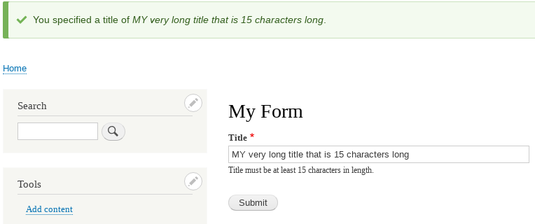Overview
It is assumed that you know how to create a module. If not, see Create a module in Drupal 8.
Create a form is similar to displaying a page. You need:
- A routing to your form.
- A class that build the form.
Create a routing for the form
Add the routing information in ./modules/tradesteps/tradesteps.routing.yml, like the following:
tradesteps.my_form: path: '/my_form' defaults: _form: 'Drupal\tradesteps\Form\MyForm' _title: 'My Form' requirements: _permission: 'access content'
A side note:
Under the defaults section, you can't have a combination of _form and _controller. It is either 1 of them.
Implement your form class
Now, you have to implement MyForm class.
Add the following code in ./modules/tradesteps/src/Form/MyForm.php and create the missing directories, i.e. src/Form.
<?php namespace Drupal\tradesteps\Form; use Drupal\Core\Form\FormBase; use Drupal\Core\Form\FormStateInterface; /** * Implements a simple form. */ class MyForm extends FormBase { /** * Build the simple form. */ public function buildForm(array $form, FormStateInterface $form_state) { // Add input field called title. $form['title'] = [ '#type' => 'textfield', '#title' => $this->t('Title'), '#description' => $this->t('Title must be at least 15 characters in length.'), '#required' => TRUE, ]; // Group submit handlers in an actions element with a key of "actions" so // that it gets styled correctly, and so that other modules may add actions // to the form. This is not required, but is convention. $form['actions'] = [ '#type' => 'actions', ]; // Add a submit button that handles the submission of the form. $form['actions']['submit'] = [ '#type' => 'submit', '#value' => $this->t('Submit'), ]; return $form; } /** * The form ID is used in implementations of hook_form_alter() to allow other * modules to alter the render array built by this form controller. it must * be unique site wide. It normally starts with the providing module's name. */ public function getFormId() { return 'tradesteps_simple_form'; } /** * Implements form validation. * * The validateForm method is the default method called to validate input on * a form. */ public function validateForm(array &$form, FormStateInterface $form_state) { $title = $form_state->getValue('title'); if (strlen($title) < 15) { // Set an error for the form element with a key of "title". $form_state->setErrorByName('title', $this->t('The title must be at least 15 characters long.')); } } /** * Implements a form submit handler. * * The submitForm method is the default method called for any submit elements. * What to do after user click on Submit button. */ public function submitForm(array &$form, FormStateInterface $form_state) { /* * This would normally be replaced by code that actually does something * with the title. */ $title = $form_state->getValue('title'); drupal_set_message($this->t('You specified a title of %title.', ['%title' => $title])); } }
Test the input form
- Clear your cache.
- Open http://your-domain.com/my_form
- Type in your title and then click on the Submit button.

Credit
- https://docs.acquia.com/tutorials/fast-track-drupal-8-coding/build-new-form/
Github
- https://github.com/xuanngo2001/drupal-form-simple.git

